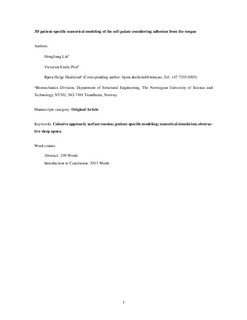| dc.contributor.author | Liu, Hongliang | |
| dc.contributor.author | Prot, Victorien Emile | |
| dc.contributor.author | Skallerud, Bjørn Helge | |
| dc.date.accessioned | 2018-08-09T13:10:05Z | |
| dc.date.available | 2018-08-09T13:10:05Z | |
| dc.date.created | 2018-08-08T13:16:34Z | |
| dc.date.issued | 2018 | |
| dc.identifier.citation | Journal of Biomechanics. 2018, 77 107-114. | nb_NO |
| dc.identifier.issn | 0021-9290 | |
| dc.identifier.uri | http://hdl.handle.net/11250/2508276 | |
| dc.description.abstract | Collapse of the soft palate in the upper airway contributes to obstructive sleeping apnea (OSA). In this study, we investigate the influence of the adhesion from the tongue on the soft palate global response. This is achieved using a cohesive zone finite element approach. A traction-separation law is determined to describe the adhesion effect from the surface tension of the lining liquid between the soft palate and the tongue. According to pull-off experimental tests of human lining liquid from the oral surface of the soft palate, the corresponding cohesive properties, including the critical normal traction stress and the failure separation displacement, are obtained. The 3D patient-specific soft palate geometry is accounted for, based on one specific patient’s computed tomography (CT) images. The calculation results show that influence of the adhesion from the tongue surface on the global response of the soft palate depends on the length ratio between the cohesive length and the soft palate length. When the length of the cohesive zone is smaller than half of the soft palate length, the adhesion’s influence is negligible. When the adhesion length is larger than 70 percent of soft palate length, the adhesion force contributes to preventing the soft palate from collapsing towards to the pharynx wall, i.e. the closing pressure is more negative than in the no adhesion case. These results may provide useful information to the clinical treatment of OSA patients. | nb_NO |
| dc.language.iso | eng | nb_NO |
| dc.publisher | Elsevier | nb_NO |
| dc.rights | Attribution-NonCommercial-NoDerivatives 4.0 Internasjonal | * |
| dc.rights.uri | http://creativecommons.org/licenses/by-nc-nd/4.0/deed.no | * |
| dc.title | 3D patient-specific numerical modeling of the soft palate considering adhesion from the tongue | nb_NO |
| dc.type | Journal article | nb_NO |
| dc.type | Peer reviewed | nb_NO |
| dc.description.version | acceptedVersion | nb_NO |
| dc.source.pagenumber | 107-114 | nb_NO |
| dc.source.volume | 77 | nb_NO |
| dc.source.journal | Journal of Biomechanics | nb_NO |
| dc.identifier.doi | https://doi.org/10.1016/j.jbiomech.2018.06.011 | |
| dc.identifier.cristin | 1600451 | |
| dc.description.localcode | © 2018. This is the authors’ accepted and refereed manuscript to the article. Locked until 27.6.2019 due to copyright restrictions. This manuscript version is made available under the CC-BY-NC-ND 4.0 license http://creativecommons.org/licenses/by-nc-nd/4.0/ | nb_NO |
| cristin.unitcode | 194,64,45,0 | |
| cristin.unitname | Institutt for konstruksjonsteknikk | |
| cristin.ispublished | true | |
| cristin.fulltext | postprint | |
| cristin.qualitycode | 2 | |

